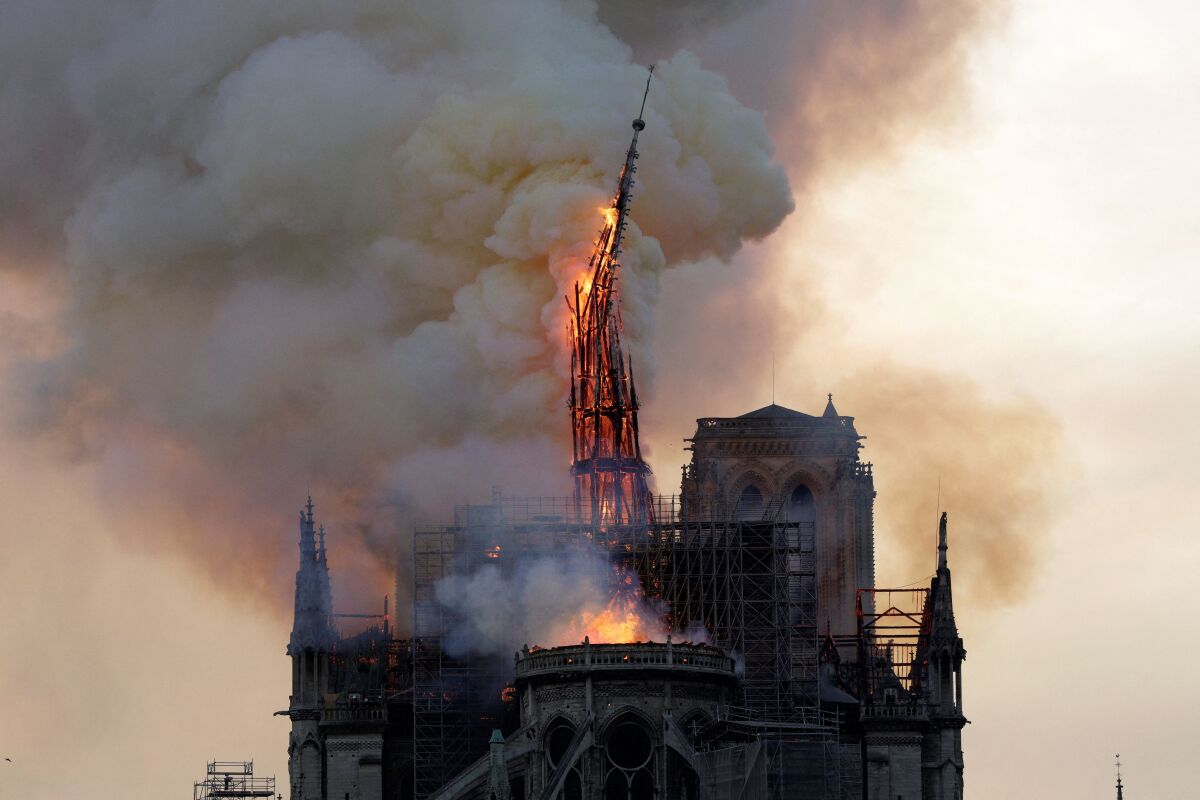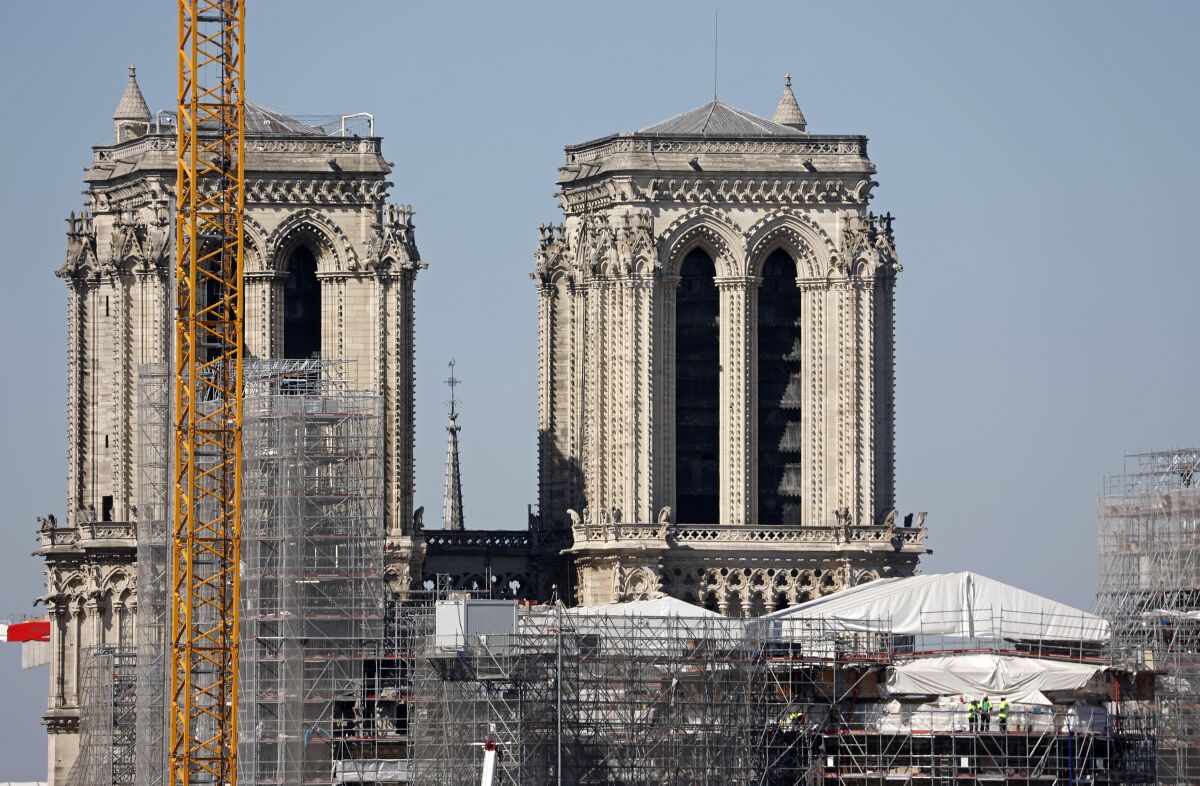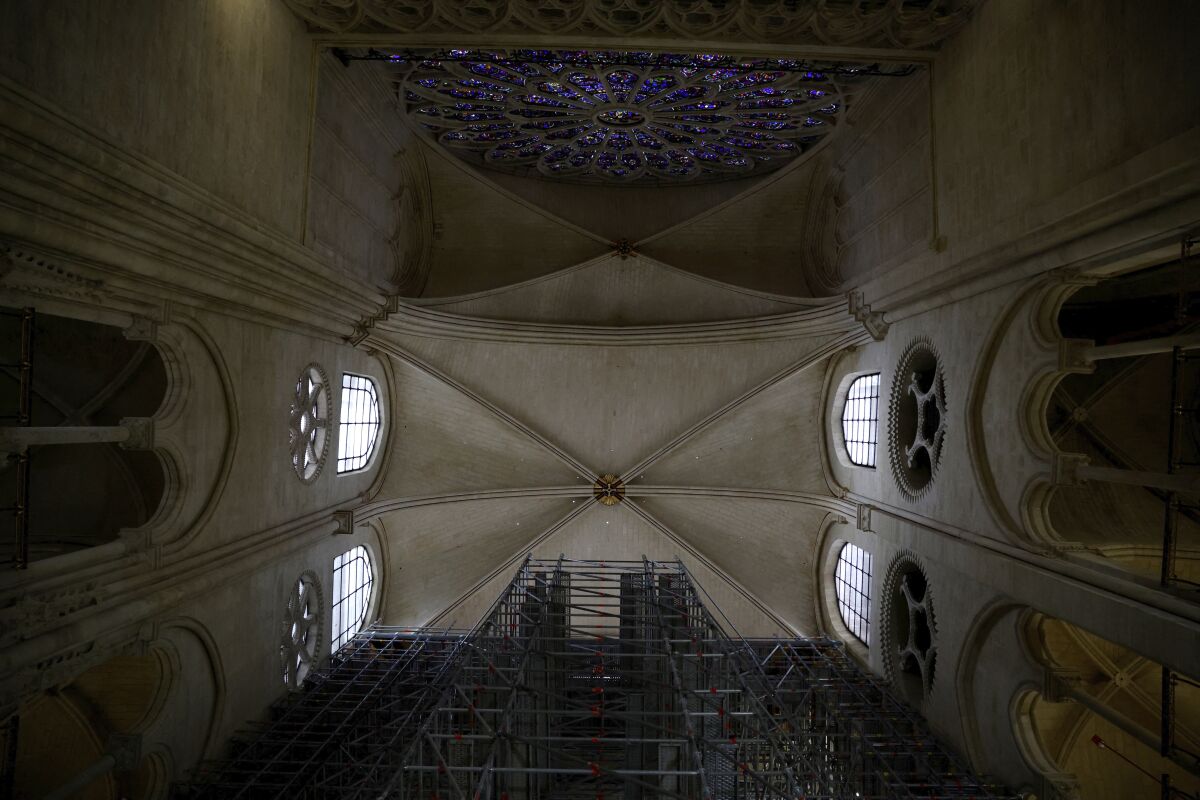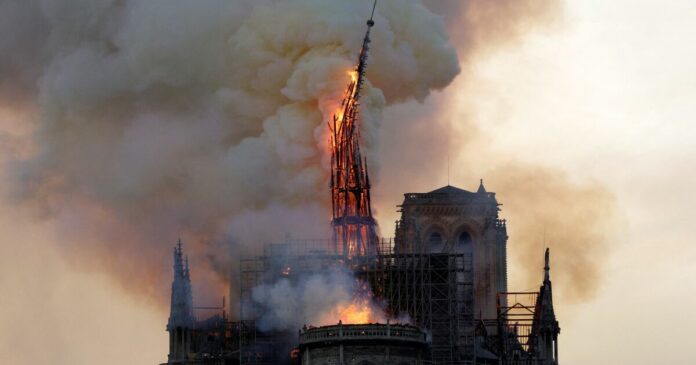PARIS — A slender taper of latticework, its filigree etched in flame against a smoke-darkened sky. Falling.
When the world’s most recognizable cathedral, Notre Dame de Paris, burned on April 15, 2019, the toppling of its spire was the catastrophe’s defining moment — a dreamlike loop endlessly replayed, a stuttering stop-time interval that seemed, improbably, to last forever.
“It was so hard to believe what we were seeing,” said Agnes Poirier, a journalist and author who was among the throngs watching the conflagration from the left bank of the Seine. She remembers the desolate cry that went up from the crowd at that moment.
Now the spire is slowly rising again.
The French government had hoped to reopen Notre Dame to worshipers and visitors in time for the Summer Olympics in 2024, when Paris will be a focus of worldwide attention and tourists will crowd the city. That target date is now December of that year.
But setting in place the spire’s cross-shaped base — a complex operation that took place after the enormous wooden trestle was constructed and then deconstructed at a sprawling work site 200 miles to the northeast — marked an important symbolic milestone in Notre Dame’s rebirth.
The 80-ton support, known as the tabouret, or stool, was built in the town of Briey by carpenters employing centuries-old woodworking craftsmanship as well as modern-day methods such as 3-D modeling and laser measurement. In recent weeks, element by giant element, it was hoisted by cranes onto the cathedral’s gusty rooftop, a bravura ballet performed 180 feet in the air.
Workers near a stained glass window under the vaults at the Notre Dame Cathedral midway through restoration work in Paris.
(Ian Langsdon / Associated Press)
“A great joy,” Jean-Louis Georgelin, the French army general in charge of the restoration, called the base’s reassembly — a crucial prelude to the delicate pinnacle eventually attaining its full height of nearly 300 feet above the ground.
“From this summer, we will see the spire …gradually rising into the sky of Paris,” the general said in a statement marking the fire’s fourth anniversary.
Poirier, who wrote an award-winning book about the fire and its aftermath, rose early the morning after the fire. In the pink glow of dawn, she gazed at the familiar silhouette of Notre Dame’s twin bell towers — and the gaping void left by the missing spire.
“She was injured,” Poirier said of the cathedral. “But still standing. Still there.”
::
As Notre Dame burned, the spire was both a casualty of the flames and a weapon of destruction that threatened the entire edifice.
Its collapse sent tons of fiery oak timbers laced with molten lead crashing to the cathedral floor, imperiling fragile walls and vaults. Experts later said that had the 400 firefighters been unable to halt the spreading blaze, the cathedral would have burned beyond repair within half an hour. An investigation into the origin of the fire, which began directly under the roof, was inconclusive.

The spire of Notre Dame Cathedral falls.
(Geoffroy Van Der Hasselt / AFP via Getty Images)
Even before the inferno, the spire was in disrepair, its degraded state a major impetus behind a restoration project launched three years earlier. It was already surrounded by scaffolding when the fire broke out, with the statues adorning it removed for safekeeping just four days earlier.
The cathedral has been spireless before — for nearly 60 years, when the badly deteriorating original, constructed in the 1200s, was taken down in the late 18th century to stop it from falling down on its own.
It was rebuilt under the auspices of the 19th century master architect Eugene Viollet-le-Duc, whose architectural drawings were carefully preserved in France’s National Archives and have served as an invaluable guide to those working to precisely replicate his creation today.
Early in the reconstruction, the design of the replacement spire was the subject of brief but passionate controversy, with proposals that included a sleek glass tower and a roof garden, even a beam of light in lieu of a structure. But traditionalists prevailed, opting to stay faithful to the original.
Before the fire, the cathedral was France’s most visited monument, drawing 13 million visitors annually. Even President Emmanuel Macron, who had initially voiced interest in a more modernist design, bowed to a popular wish that whatever alchemy occurred in reconstruction, this particular iconic component — the spire — should return in recognizable form.

The towers of Notre Dame Cathedral almost four years after fire ravaged Paris’ emblematic monument.
(Chesnot / Getty Images)
“For myself, I was relieved, and I think donors were,” said Michel Picaud, the president of Friends of Notre Dame de Paris, a group whose fundraising inside and outside France is helping defray the reconstruction costs, estimated at more than a billion dollars.
Picaud is 69, and in a country where retirement at a relatively early age is a cherished goal, his adult children often chide him for not stepping down. But his wife of 40 years, Cecile, who stood with him into the early-morning hours as the cathedral smoldered nearby, understands his sense of mission, he said.
“At first, I wanted to weep,” said Picaud, a Paris native. “But then, I thought only of rebuilding.”
::
Nearly 6,000 miles away in Los Angeles, the televised sight of leaping flames tumbled Father German Sanchez into memories of his time as a seminarian in France. To him, Notre Dame was an unchanging presence, a source of immense peace and calm.
What he didn’t know was how many among his flock at St. Sebastian’s, a multicultural parish in West Los Angeles, would share his sense of loss and dismay when it burned.
“It was astonishing to me, the sentiments everyone seemed to have in common,” said Sanchez, a native of Colombia who ministers to the local French-speaking community as well as parishioners from across Latin America and an array of countries including Vietnam, Belgium, Britain and the Philippines.
“Every weekend, we have six continents represented,” he said proudly.
Sanchez said he was heartened by the pace of the cathedral’s reconstruction, which he has followed closely over the last four years. In the days following the fire, he said parishioners spontaneously asked how they could help — including a 10-year-old boy who gravely informed the priest he had a dollar he wanted to donate.
Some critics inside and outside France have complained that the outpouring of financial support for Notre Dame’s rebuilding reflects a turning away from other urgent needs, especially those centered on human suffering — war and hardship, poverty and hunger.
Picaud, the fundraiser, said he didn’t see a simple dichotomy.

Scaffolding in the nave of the Notre Dame Cathedral.
(Sarah Meyssonnier / Associated Press)
“If people want to help, there isn’t only one ‘pot’ for their compassion,” he said. “You don’t need to support only one need, one cause.”
Sanchez said he believed emotion surrounding Notre Dame did not necessarily involve religious faith. In a message to his congregation days after the cathedral went up in flames, he called it a house of God, but a home to all.
“Notre Dame is a witness to humanity’s history,” he wrote. “This fire reminds us how fragile our existence is.”
::
Viollet-le-Duc, the 19th century architect, made at least one design choice that might be viewed as a touch of cheekiness, a sly nod to his own vanity — or a paean to his belief that the spire’s construction, in his time, was an enormously consequential task.
When statues of the 12 apostles and four evangelists were commissioned to decorate the spire, he had the face of St. Thomas, the patron saint of architects, modeled on his own. While the other figures are depicted with a downward gaze, as if watching over the cathedral and the people of Paris, St. Thomas’ likeness looks upward, as if contemplating the spire itself.
The assembled statuary, together with many artifacts of Notre Dame’s damage and reconstruction, is currently on display at Paris’ City of Architecture and Heritage museum. Curator Lisa Bergugnat said if there was any positive side to the disaster, it was the public getting an intimate look at objects that would be otherwise inaccessible.

A crane carries a worker at Notre Dame last year.
(Alfonso Jimenez Valero / Anadolu Agency via Getty Images)
“Instead of being high on the spire, they are right here, where people can see them,” she said.
When the timbered framework and lead sheathing nears completion, at the end of this year, the statues will be put back.
To Poirier, the author, there is a certain poignancy in the notion of the spire again becoming visible in coming months, bit by bit. Not all loss, she said, is irretrievable.
Sanchez, the priest, understands well the theological underpinnings of all church spires and steeples — a pointing toward heaven, a rising up of prayers. But he sees a more universal symbolism at work as well.
“It draws us upward, not down,” he said. “Life is sometimes very difficult, and always we need to have this invitation. Look up.”


